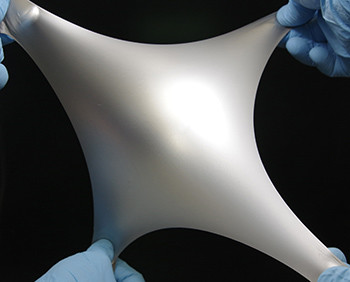Thermally conductive rubber for soft, stretchy electronics

Researchers from Carnegie Mellon University have developed a material called ‘thubber’ — a thermally conductive rubber material that represents a breakthrough for creating soft, stretchable machines and electronics. The electrically insulating composite exhibits a combination of metal-like thermal conductivity and elasticity similar to biological tissue that can stretch over six times its initial length.
Writing in the journal Proceedings of the National Academy of Sciences, the researchers explained that emerging domains such as wearable computing and soft robotics “require thermally conductive materials that are also soft and stretchable. However, heat transport within soft materials is limited by the dynamics of phonon transport, which results in a trade-off between thermal conductivity and compliance.”
Associate Professor Jonathan Malen and Associate Professor Carmel Majidi overcame this constraint by engineering an elastomer composite embedded with elongated inclusions of non-toxic, liquid metal microdroplets. The liquid state allows the metal to deform with the surrounding rubber at room temperature. When the rubber is pre-stretched, the droplets form elongated pathways that are efficient for heat travel.
The incorporation of the microdroplets enabled the researchers to achieve a ~25x increase in thermal conductivity over the base polymer under stress-free conditions and a ~50x increase when strained. Despite the amount of metal, the material was also electrically insulating.

To demonstrate their findings, the team mounted an LED light onto a strip of the material to create a safety lamp worn around a jogger’s leg. The thubber dissipated the heat from the LED, which would have otherwise burned the jogger. The researchers also created a soft robotic fish that swims with a thubber tail, without using conventional motors or gears.
“Until now, high-power devices have had to be affixed to rigid, inflexible mounts that were the only technology able to dissipate heat efficiently,” said Associate Professor Malen. “Now we can create stretchable mounts for LED lights or computer processors that enable high performance without overheating in applications that demand flexibility, such as light-up fabrics and iPads that fold into your wallet.”
The researchers believe their stretchable electronic material could make an impact in applications such as heated garments for injury therapy, advanced manufacturing, energy and transport. Associate Professor Majidi noted, “Our combination of high thermal conductivity and elasticity is especially critical for rapid heat dissipation in applications such as wearable computing and soft robotics, which require mechanical compliance and stretchable functionality.”
Organic transistor 'limitation' improves stability
Researchers have shown that a longstanding organic transistor design limitation actually improves...
OLED circular polarisation is now electrically switchable
Researchers have discovered a way to control left- or right-handed polarised light via charge...
Nanoscale pixels to advance augmented reality eyewear
Physicists have developed extremely small pixels that can be used in compact AR glasses, using...





